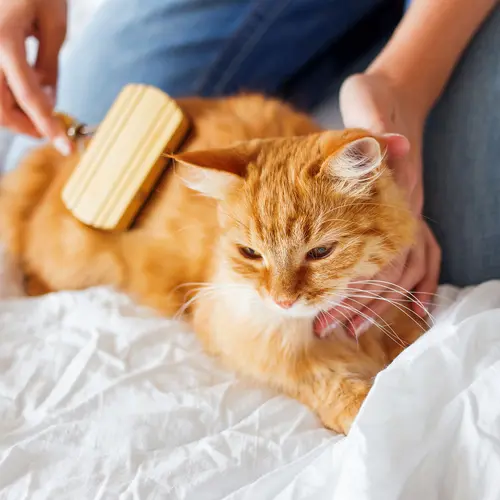While it’s safer for cats to stay indoors and away from dangers like disease and traffic, most house cats are overweight and underactive. Just like people, cats benefit from physical and mental activity. Exercise helps them relieve stress, build muscle, and prevent or reduce unwanted behaviors.
The simplest way to help your cat get up and moving is to trigger their instincts with cat toys.
Types of Cat Toys
Cat toys come in many shapes and sizes, and each cat has their own preferences. Here are a few main types to try during playtime with your cat.
Catnip toys. The majority of cats in the U.S. like catnip. Catnip can be stuffed into toys, packed into balls, or simply sprinkled into cardboard boxes. Cats can safely eat catnip, so don’t worry if they lick it.
Just be careful petting your cat when catnip’s in play: some cats get overexcited and may bite when this herb is around.
Some catnip toys you might like to try:
- Catnip-stuffed balls
- Dried catnip in newspaper
- Fresh catnip plants
Ball toys. The biggest element of most cats’ play drive is their instinct to hunt prey. Ball toys mimic the movement of prey animals, and many ball toys can include enticing elements like catnip, noisemakers, fur and feathers, or treats. As long as you’re willing to retrieve these toys from under the couch, ball toys are an excellent option for anytime enrichment.
Some ball toys you might like to try:
- Wadded-up paper
- Balls shaped like mice
- Ping-pong balls
- Balls with bells
Wand toys. Wand toys are typically sticks with a string or ribbon dangling off the end. They may also have toys, feathers, or noise-makers at the far end of the string to attract your cat’s attention. These toys let you entice your cat from a distance, so you’re not at risk from your kitty’s claws.
It’s important to put wand toys away at the end of playtime. Why? Three reasons:
- A toy that’s only available occasionally is more interesting to your cat.
- Feathers and ribbons can easily be chewed apart by your cat if it’s left out.
- Cats value interaction with people even more than they value most toys. Keeping the toy connected to playtime — and to you — helps you build your relationship with them.
Some wand toys you might like to try:
- “Fishing pole” type toys
- Homemade wands, like a ruler and shoelace (be careful that your cat doesn't ingest the shoelace)
- Large, colorful feathers from a craft store
Food-dispenser toys. Free-feeding cats, or leaving food out at all times, is convenient. However, it can easily lead to overweight animals. Food-dispensing toys mimic the requirements of hunting for food and keep your cat from eating too much throughout the day.
Before feeding your cat entirely through food-dispensing toys, take the time to train them. Place the toys around the house full of treats and reward your pet for exploring the toys. Once they’ve learned how the toys work, you can slowly decrease the amount of food in their dish and increase the kibble in their toys until they’re eating entirely from toy hunting.
Play Session Planning
Cats enjoy the thrill of the hunt, even indoors. The more you can simulate the hunt for prey during playtime, the more fun your cat will have. Whether you’re making the toy “flee” from your cat or you’re allowing your cat to win and “kill” it, your cat will benefit from the exercise and mental effort.
Other guidelines to keep in mind to engage your cat in play include:
- Choose toys your cat enjoys. Every cat has preferences. If your cat loves wand toys but ignores balls, follow their lead.
- Protect your appendages. Cats bite on instinct when they’re “hunting”. Keep your fingers and hands away from their mouth and don’t encourage rough play in kittens. Otherwise, it can quickly become painful to play with them as they grow.
- Don’t be afraid to take breaks. If your cat seems overexcited and attacks your hands or feet, back off. Come back and reinitiate play when they’re a little calmer.
- Avoid laser lights. Many cats find lasers that they can’t catch to be frustrating. Instead, use wand toys that your cats can catch.
- Play at different times. Just like you might be a night or a morning person, your cat will have more energy during different times of day. Experiment to see when your cat enjoys playing the most, and then schedule some one-on-one time with your pet to encourage them to exercise.
- Play with all your cats. If you have multiple cats, one will probably dominate playtime in a group. If you need to, separate your cats to ensure they all get attention.
- Avoid dangerous toys. Don’t allow your cat to play with sharp objects, ribbon, rubber bands, plastic bags, or any small items they could accidentally swallow.
Keeping your cat active is a key part of enriching your cat’s life. Some of these ideas for play may also be useful in training your cat, too.


